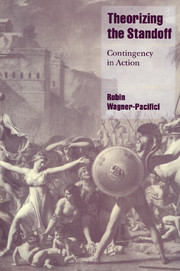5 - Endings and improvisations
Published online by Cambridge University Press: 22 September 2009
Summary
The innovation introduced by the Latin system above all consists in the ordered and regular way in which the theme of temporality, so to speak, is reduplicated through the contrast between the infectum [describing the process on its way towards completion] with the perfectum [describing the completed process].
(Ferdinand Gonseth, Time and Method, p. 151)At a demonstration that passed close to the Ambassador's residence today, Peruvians, in tacit acknowledgment of how delicate the standoff had become, spoke not for a quick end to the crisis but for a peaceful one. “It would be a shame for this to all end in bloodshed after we've come so far,” said Lucia Perez, a nurse. “I don't care when it ends as long as it ends peacefully.”
(New York Times, January 2, 1997, A1)It may seem either self-serving or dangerous for a book's concluding chapter to begin with the assertion that conclusions are extremely important. But it is indeed the case that the way a standoff ends will have much to do with whether its management as a situation of conflict and paralysis will be considered a success or a failure. As the times and spaces of the standoffs have taken their various shapes, and as the actions of the standoffs have engaged the participants in the generation of a variety of texts, speeches, and gestures (that have fed back dynamically into the participant identities themselves), the standoffs have all moved through time towards their resolutions.
- Type
- Chapter
- Information
- Theorizing the StandoffContingency in Action, pp. 214 - 237Publisher: Cambridge University PressPrint publication year: 2000

